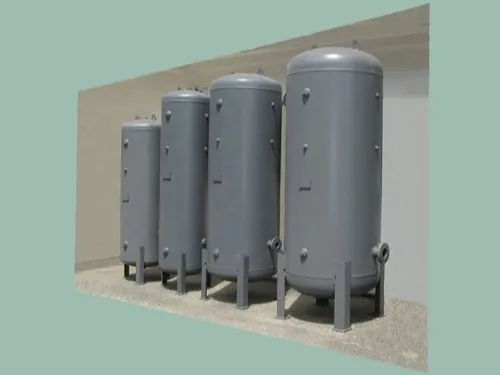High Pressure Air Receiver Tank
₹45,000.0
| Minimum Order Quantity | 1 Unit |
| Tank Orientation | Vertical |
| Storage Capacity | 100000 L |
| Material | MS |
| Usage/Application | Air Storage |
| Storage Capacity (in Litres) | 1000 L |
| Pressure Rating | 100-150 psi |
| Brand | Krish Engineering |
| Thickness | 50 mm |
| Country of Origin | Made in India |
- Description
- Additional information
- Reviews (0)
- Q & A
- Sustainability Remark
- More Offers
- Store Policies
- Inquiries
High Pressure Air receiver Tank
Features:
- Easily affordable
- Long lasting material quality
- Excellent fabrication
- Tough and tensile
- Robust and strong
Additional Information:
- Pay Mode Terms: L/C (Letter of Credit),T/T (Bank Transfer),D/P,D/A,Other
- Production Capacity: 10PER MONTH
- Delivery Time: 03TO04WEEK
| brands | KRISH ENGINEERING |
|---|
You must be logged in to post a review.
Q & A
Compressed air receivers, also known as air storage tanks, are commonly used in various industrial applications to store compressed air for later use. The sustainability of a compressed air receiver depends on several factors:
Energy Efficiency: Compressed air systems are known for their relatively low energy efficiency. When compressed air is stored in a receiver, there is a potential for energy loss due to leaks and heat transfer. To improve sustainability, it's important to design and maintain the system to minimize air leaks and implement insulation to reduce heat transfer.
System Design: The design of the compressed air system, including the receiver, plays a significant role in its sustainability. Properly sizing the receiver to match the demand can help optimize energy usage and reduce unnecessary cycling of the compressor. Additionally, incorporating efficient control mechanisms, such as variable speed drives, can further enhance the system's sustainability.
Maintenance and Leakage: Regular maintenance is crucial to ensure the sustainable operation of a compressed air receiver. Inspecting and repairing leaks promptly can prevent energy wastage and reduce the overall environmental impact. Implementing a leak detection and repair program can help identify and fix leaks in a timely manner.
Material Selection: The choice of materials used in the construction of the compressed air receiver can impact its sustainability. Opting for materials that are durable, corrosion-resistant, and recyclable can extend the lifespan of the receiver and reduce waste generation.
Integration with Renewable Energy: To enhance sustainability, compressed air systems can be integrated with renewable energy sources. For instance, using solar or wind power to generate electricity for compressors can reduce the reliance on fossil fuels and decrease the environmental footprint of the system.
Life Cycle Assessment: Conducting a life cycle assessment (LCA) of the compressed air system, including the receiver, can provide a comprehensive understanding of its environmental impact. LCAs consider the energy consumption, raw materials, manufacturing processes, transportation, usage, and disposal of the system. This analysis helps identify areas for improvement and guide sustainable decision-making.
It's worth noting that compressed air should be used judiciously, as it can be an inefficient form of energy compared to other alternatives. It is advisable to evaluate whether compressed air is the most suitable choice for a given application, considering factors such as energy efficiency, cost-effectiveness, and environmental impact.
General Inquiries
There are no inquiries yet.





Reviews
There are no reviews yet.